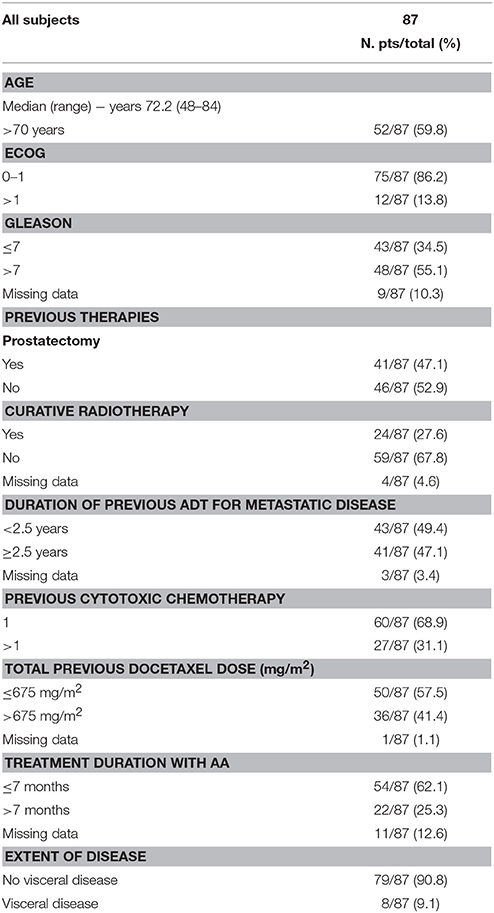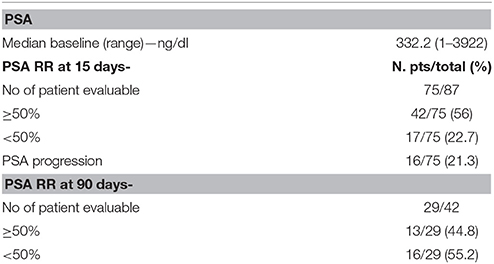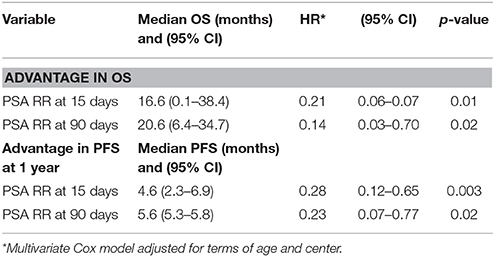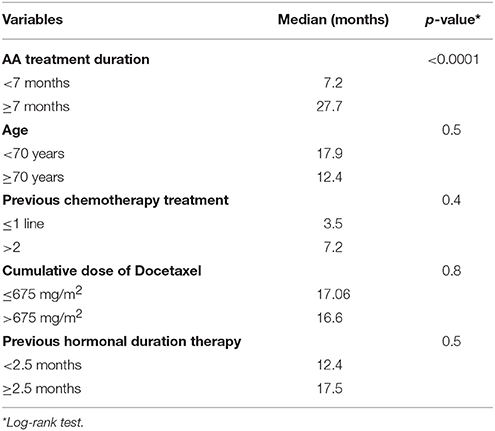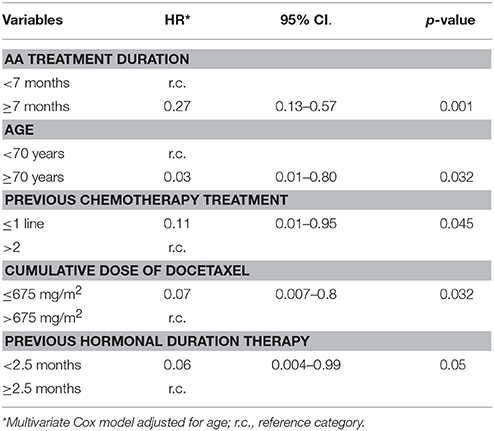- 1Division of Medical Oncology, Department of Uro-Gynaecological Oncology, Istituto Nazionale Tumori “Fondazione G. Pascale” - IRCCS, Naples, Italy
- 2Department of Medical Oncology, Santa Chiara Hospital, Trento, Italy
- 3Medical Oncology Department, Institute for Cancer Research and Treatment, Candiolo, Italy
- 4Department of Onco-Ematology Medical Oncology, S.G. Moscati Hospital of Taranto, Taranto, Italy
- 5Unit of Epidemiology, Struttura Complessa di Statistica Medica, Biometria e Bioinformatica, Fondazione IRCCS Istituto Nazionale Tumori, Naples, Italy
- 6Department of Medical Oncology, National Cancer Institute, Aviano, Italy
Background: Abiraterone Acetate (AA) is approved for the treatment of mCRPC after failure of androgen deprivation therapy in whom chemotherapy is not yet clinically indicated and for treatment of mCRPC progressed during or after docetaxel-based chemotherapy regimen. The aim of this study is to evaluate the role of early PSA decline for detection of therapy success or failure in mCRPC patients treated with AA in post chemotherapy setting.
Patients and Methods: We retrospectively evaluated 87 patients with mCRPC treated with AA. Serum PSA levels were evaluated after 15, 90 days and then monthly. The PSA flare phenomenon was evaluated, according to a confirmation value at least 1 week apart. The primary endpoint was to demonstrate that an early PSA decline correlates with a longer progression free survival (PFS) and overall survival (OS). The secondary endpoind was to demonstrate a correlation between better outcome and demographic and clinical patient characteristics.
Results: We have collected data of 87 patients between Sep 2011 and Sep 2014. Early PSA response (≥50% from baseline at 15 days) was found in 56% evaluated patients and confirmed in 29 patients after 90 days. The median PFS was 5.5 months (4.6–6.5) and the median OS was 17.1 months (8.8–25.2). In early responders patients (PSA RR ≥ 50% at 15 days), we found a significant statistical advantage in terms of PFS at 1 year, HR 0.28, 95%CI 0.12–0.65, p = 0.003, and OS, HR 0.21 95% CI 0.06–0.72, p = 0.01. The results in PFS at 1 years and OS reached statistical significance also in the evaluation at 90 days.
Conclusion: A significant proportion (78.6%) of patients achieved a rapid response in terms of PSA decline. Early PSA RR (≥50% at 15 days after start of AA) can provide clinically meaningful information and can be considered a surrogate of longer PFS and OS.
Introduction
Prostate cancer growth depend on signaling from the activated androgen receptor (AR). Nearly 90% of all patients with metastatic prostate cancer initially respond to castration-induced androgen deprivation. Unfortunately, this therapeutic response is not lasting, with a median duration of 18–24 months, after which the tumor progresses despite hormonal castration levels, so we define a prostate cancer as castration-resistant (CRPC). Some authors reported that the AR remains activated and plays an important role during the progression of metastatic CRPC (mCRPC; Zhu et al., 2010; D'Aniello et al., 2014; Zhang et al., 2015). Several mechanisms are involved such as: genomic amplification and over expression of AR, gain of function mutations of AR, up-regulation of AR enhancer elements, alterations in androgen transport, increased synthesis of extra gonadal androgens, abnormalities in AR co-activators and co-regulators, ligand-independent trans-activation of AR by growth factors or cytokines, and AR splice variants (Rathkopf and Scher, 2013). Docetaxel was the first systemic therapy to show an improvement in overall survival (OS) in patients with mCRPC (Petrylak et al., 2004; Tannock et al., 2004). Recently, different agents with different mechanisms of action have demonstrated efficacy, and four new drugs (cabazitaxel [CBZ], sipuleucel-T, enzalutamide [ENZ], and abiraterone acetate [AA]) were approved for mCRPC treatment (de Bono et al., 2010, 2011; Kantoff et al., 2010; Fizazi et al., 2012; Scher et al., 2012; Bahl et al., 2013; Di Lorenzo et al., 2013). Among these, AA is an inhibitor of the androgen biosynthesis enzyme CYP17 (17-a-hydroxylase and C17, 20-lyase) and it has been approved for treatment of mCRPC after failure of androgen deprivation therapy in whom chemotherapy is not yet clinically indicated and for the treatment of mCRPC progressed on or after a docetaxel-based chemotherapy regimen (de Bono et al., 2011; Fizazi et al., 2012).
The COU-AA 301 trials demonstrated a prolonged OS in AA–prednisone group than in the placebo–prednisone group. Median time to PSA progression was 8.5 months in the AA group vs. 6.6 months in the placebo group with a confirmed advantage in the AA treatment (Marra et al., 2008; Facchini et al., 2010; de Bono et al., 2011; Fizazi et al., 2012; Zhou et al., 2014).
In this context, it is required the validation of predictive markers of response. PSA decline after cytotoxic chemotherapy has been identified as a valid surrogate for OS and PSA progression-free survival at 3 months, in fact its reductions may reflect reductions in tumor burden. Many retrospective reports confirmed that patients with mCRPC who had a 50% decline in PSA from baseline, had a survival improvement, compared with patients who did not achieve 50% reduction in PSA (Smith et al., 1998; Scher et al., 1999; Small et al., 2002; Halabi et al., 2013). However, to date, its role as surrogate OS endpoints remains uncertain, especially in the course of non-cytotoxic therapies such as new-generation hormonal agents for still few data in this setting. Recent evidences demonstrate that tubulin-targeting drugs (docetaxel) cause cytoplasmic AR sequestration ex vivo (Jiang and Huang, 2010; Zhu et al., 2010; Buonerba et al., 2011; Mezynski et al., 2012) and in circulating tumor cells (Buonerba et al., 2011), significant down-regulation of AR and PSA expression, and nuclear accumulation of the fork head transcription factor family member FOXO1. This last is a potent repressor of AR function (Gan et al., 2009; Kuroda et al., 2009; Franco et al., 2011) and suggest the strong evidence that the antitumor activity of docetaxel is also associated with disruption of AR signaling. These data could support the hypothesis of a cross-resistance between docetaxel and AA. The activity of AA, similarly, also appears to differ according to its sequencing with docetaxel (Caraglia et al., 2005; Mezynski et al., 2012; Loriot et al., 2013). The aim of our retrospective analysis is to demonstrate that an early PSA decline correlates with longer progression free survival (PFS) and OS in order to validate this parameter as an early predictive marker of AA response, in order to exclude from treatment patients non-responders, therefore reducing costs, and serial determinations of PSA.
Patients and Methods
This retrospective study enrolled 87 patients at three sites in Italy (National Cancer Institute of Naples–Fondazione G. Pascale, Oncological Institute of Candiolo and Santa Chiara Hospital in Trento) with histologically confirmed metastatic prostate cancer, who became refractory to hormonal therapy, and progressed after chemotherapy (treated with at least one line docetaxel containing regimen). All patients received AA (1000 mg orally once daily at least 1 h before or 2 h after meal, with prednisone 10 mg daily). Each cycle of treatment was 28 days long. All patients maintained androgen deprivation with a serum testosterone level of 50 ng per decilitre or less (≤2.0 nmol per liter). During AA treatment, patients monthly had a check of their hematological parameters. PSA value was recorded after 15 days from the start of therapy and then monthly. Tumor assessment with computed tomography (CT) and/or bone scan was performed at baseline and then every 3 months or as clinical indicated. Baseline ECG and Echocardiogram were obtained and further cardiac work-up was performed if indicated. Treatment could be continued until disease progression, which was defined based on the Prostate Cancer Working Group II criteria, death or unacceptable toxicity. In case of biochemical progression only during the first 3 months of treatment, evidence of radiological/metabolic progression was required to stop the therapy. Patients were stratified according to variables considered potential predictors of better outcome included: baseline ECOG performance status score (0 or 1 vs. 2), age (≤70 vs. >70 years), Gleason score (≤7 vs. >7), previous prostatectomy (yes or no), previous curative radiotherapy (yes or no), duration of previous ADT for metastatic disease, number of previous chemotherapy regimens (1 vs. >1), extent of disease (visceral vs. non-visceral disease), previous cumulative docetaxel dose expressed in mg/m2 (≤675 vs. >675 mg/m2), duration of AA treatment. Table 1 summarizes Baseline Demographic and Clinical Patient Characteristics.
Early PSA response rate (PSA RR) was assessed 15 days after the start of treatment, and then after 12 weeks (according with PCWG 2). Early PSA RR (at 15 days) was defined as a ≥50% reduction from baseline, stratifying patients as early responders or early non-responders PSA and PSA Progression for an increase of 25% or 5 ng/ml absolute value from baseline (Table 2). Our aim is to demonstrate that an early PSA decline correlate with longer PFS and OS in order to validate this parameter as an early predictive marker of response to AA, excluding patients non-responders and therefore reducing costs treatment related and serial determinations of PSA.
Statistical Analyses
We record the time from the initial treatment with AA to progression as PFS; OS was defined as the time from the last follow-up to death. Univariate analysis for PFS and OS were calculated according to the Kaplan-Meier method. Statistical differences between curves were calculated using log-rank test. We analyzed PSA response rates computing a percentage-reduction at 15 days and 90 days through the following formula: [(a – b)/b*100] where a) baseline PSA; b) 15 days PSA or 90 days PSA; the proportion of patients with a decrease of ≥50% in the PSA concentration from the baseline PSA value were considered the best category. The Cox proportional hazards model was used to test the effect of PSA response rates on survival outcomes in multivariate analyses. Hazard ratios (HRs) and 95% CIs were estimated, adjusting for age and the PSA response rates were investigated as independent factors (Figure 1). Stratified analyses were carried out to assess whether PSA response rates were consistent across subgroups. A p < 0.05 was considered significant. Statistical analysis was performed using SPSS (version 21; SPSS, Inc., Chicago, IL).
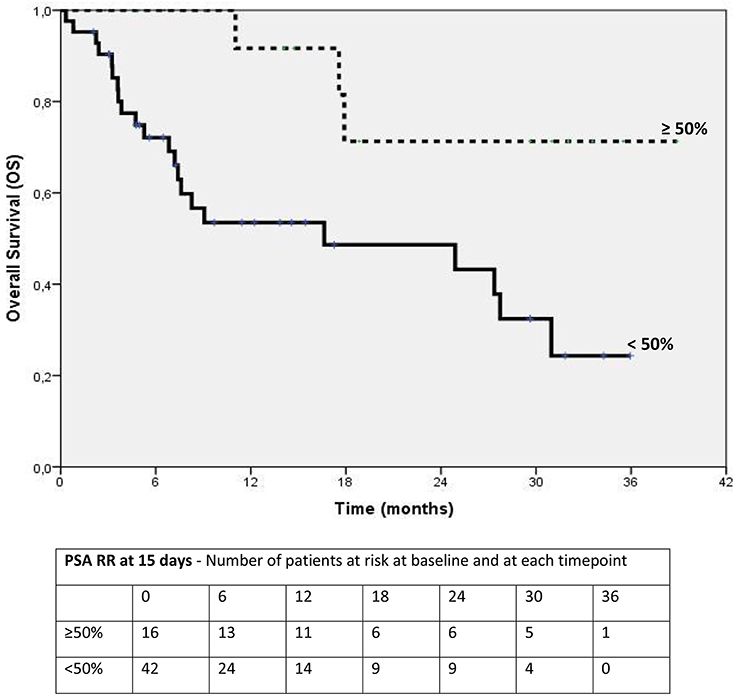
Figure 1. Kaplan-Meier estimates of Overall Survival according to PSA response rate* at 15 days. *Defined as the proportion of patients with a decrease of ≥50% in the PSA concentration from the basline PSA value to 15 days.
Results
Between Sep 2011 and Sep 2014, 87 patients' records were located, all had sufficient follow-up information and 75/87 were eligible for correlation analysis. The Table 1 summarize baseline patients' characteristics. Median serum PSA value at baseline was 332.2 ng/dl (range: 1–3922). PSA decline was observed in 78.6% (59/75) of patients. Early PSA response (≥50% from baseline at 15 days) was found in 56% (42/75) evaluated patients. At 90 days after starting AA, 29/42 patients confirm a PSA value of response. Confirmed PSA RR ≥ 50% was found in 31% (13/29). In early responders patients (PSA RR ≥ 50% at 15 days), we found a significant statistical advantage in terms of PFS at 1 year, HR 0.28, 95%CI 0.12–0.65, p = 0.003, and OS, HR 0.21 95% CI 0.06–0.72, p = 0.01 (Figure 1). The median OS was 17.1 months (8.8–25.2). In this group of early PSA responders, we evaluated the confirmed PSA RR at 90 days. The results in PFS at 1 years and OS (Figure 2) reached statistical significance, HR: 0.23 95% CI 0.07–0.77, p = 0.02 and HR: 0.14 95% CI 0.03–0.70, p = 0.02, respectively (Tables 2, 3). The proportion of patients alive at 1 year was 88% (n = 15) in PSA ≥ 50% and 12% (n = 5) in PSA < 50%; no patients were observed without progression at 1 year in both categories. Our analysis showed a positive correlation between OS and duration of AA treatment in early responders. Patients treated for more than 7 months with AA had a significant longer survival, HR 0.27 95% CI 0.13–0.57, p = 0.001.
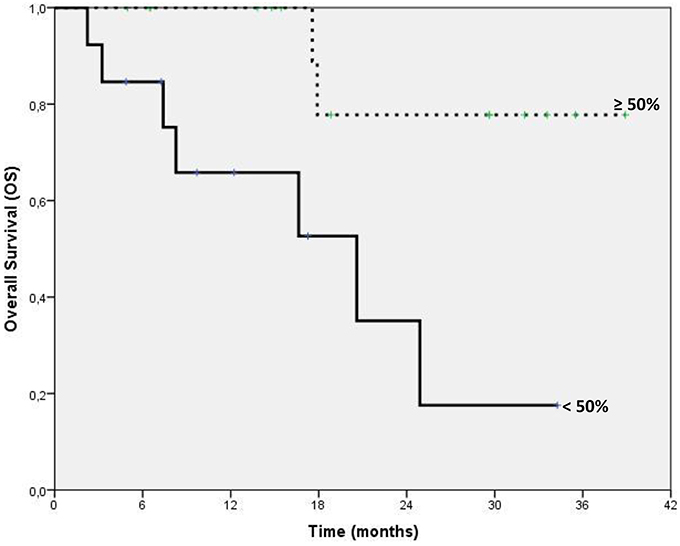
Figure 2. Kaplan-Meier estimates of Overall Survival according to PSA response rate at 90 days*. *Subgroup of 29 patients with confirmation of response obtained at 15 days included in the analysis of PSA response at 90 days.
Patients with more than 70 years old had a longer OS, HR 0.03 95% CI 0.01–0.80, p = 0.032. The improvement in OS was achieved also in patients with one previous chemotherapy treatment, HR 0.11 95% CI 0.01–0.95, p = 0.045. Early responders who received a cumulative dose of docetaxel ≤675 mg/m2 confirmed a statistical advantage in OS, HR 0.07 95% CI 0.007–0.8, p = 0.032. Previous hormonal therapy duration (≥2.5 months) for metastatic setting correlated with longer OS, HR 0.06 95% CI 0.004–0.99, p = 0.05. These results are summarized in Tables 4, 5. Concerning the other stratification, we do not found a significant statistical correlation in terms of PFS and OS.
Discussion
mCRCP is a heterogeneous disease in which AR remains activated and plays an important role during the progression of mCRPC. Several mechanisms contribute to continue AR signaling in mCRPC (Rathkopf and Scher, 2013). A significant percentage of patients with mCRPC that progresses in the course or after docetaxel are potential candidates to additional treatments in order to be able to increase OS (de Bono et al., 2011; Fizazi et al., 2012). Until few years ago, there were few therapeutic opportunities, formally recognized, with no outcome in terms of survival. To date there are at least three approved drugs such as AA, CBZ and ENZ (Bubley et al., 1999; de Bono et al., 2010, 2011; Fizazi et al., 2012; Scher et al., 2012; Bahl et al., 2013; Di Lorenzo et al., 2013).The most important question mark remains how to choose the best treatment sequencing and if there are some early response marker to guide clinical choice. To make effective use of secondary therapies there is a definite need to predict clinical or biological markers for early identification of non-responders patients, who may benefit from alternative treatments thus allowing a reduction in costs. All recent phase III trials have used as criteria for assessing the efficacy of some drugs, those established by the Prostate Cancer Working Group 2 (PCWG 2) criteria (Scher et al., 2008). These criteria define the efficacy of drugs in phase II trials and demonstrate whether the therapeutic effects observed justified further evaluation in large-scale phase III trials. These criteria do not reflect the clinical reality and are often difficult to apply. Many prognostic factors predict OS after docetaxel therapy (including pre-treatment variables such as bone pain, visceral metastases, performance status, anemia, bone scan progression, and PSA) but none of these variables is predictive of responses to new hormonal treatments (Armstrong and Febbo, 2009). Although several prostate cancer–associated antigens have been identified, PSA is the most commonly used (Miles et al., 2008). Many studies found that a PSA decline of > 50%, following chemotherapy, was highly prognostic because of is an early marker of drug activity and a potential surrogate of OS (Bubley et al., 1999; Petrylak et al., 2006; Armstrong et al., 2007a; Hussain et al., 2009; Caffo et al., 2012; Kijima et al., 2012). It is known that PSA can reflect the burden of disease in men with mCRPC. Decline in PSA value can reflect a reduction in disease burden and a potential clinical benefit with cytotoxic chemotherapy or hormonal agents (Vollmer et al., 1998; Scher et al., 1999; Armstrong et al., 2007b, 2012). There is a direct relationship between AR activity and PSA production. Hence, PSA could be a valid clinical marker to minimize patient exposure to ineffective therapy. Other retrospective studies based on clinical experience such as the Caffo et al. one (Caffo et al., 2014), aimed at identifying factors predicting primary resistance to new-generation hormonal agents. In this study, the role of these parameters was clearly demonstrated only in the cumulative analysis of patient treated with ENZ while in the AA group was not confirmed. Another study, presented at ASCO GU 2015 (Rescigno et al., 2015) conducted on 124 patients who had received AA post-docetaxel demonstrated that the PSA response of ≥30% at 4 weeks from the baseline was significantly correlated with OS (P < 0.001) in multivariate analyses including other established prognostic factors in mCRPC (ECOG PS, albumin, PSABL, ALP, LDH, Hemoglobin). In our study, the aim was to evaluate an early PSA RR, defined as ≥50% reduction from baseline at 15 days after started AA, and confirmed at 90 days (according PWCG2) as surrogate of increased PFS at 1 year and prolonged OS. In early responders patients we found a significant statistical advantage in terms of PFS at 1 year, HR 0.28, 95% CI 0.12–0.65, p = 0.003, and OS, HR 0.21 95% CI 0.06–0.72, p = 0.01. AA treatment lasting more than 7 months, one previous chemotherapy treatment, a cumulative dose of docetaxel ≤675 mg/m2 and previous hormonal therapy duration ≥2.5 years, correlated with longer OS.
A PSA expression correlated with the activation of AR. PSA decline seemed to be an excellent surrogate for survival in AR-driven tumor but not in AR-independent one. Docetaxel caused cytoplasmic AR sequestration ex vivo (Jiang and Huang, 2010; Zhu et al., 2010; Buonerba et al., 2011; Mezynski et al., 2012) and in circulating tumor cells (Darshan et al., 2011) with significant down-regulation of AR and PSA expressions, so the PSA value seemed not to be useful in CRPC AR-independent (Caraglia et al., 2005; Kuroda et al., 2009; Loriot et al., 2013; Caffo et al., 2015). Conversely, recent evidences have demonstrated the molecular heterogeneity of CRPC in terms of re-expression of the AR for genomic amplification, over-expression and up regulation after docetaxel treatment. The persistent activation of AR signal in all stages of CRPC has led to consider PSA decline as a valid predictive marker of treatment response and a surrogate of longer OS in apparently AR-independent CRPC (Armstrong et al., 2012; Rathkopf and Scher, 2013).
In any case the treatment with AA has been successfully continued even in those who did not register a reduction in early PSA with a median follow-up survival of 27.7 months in patients with a duration treatment of more than 7 months Probably this will lead us to distinguish patients in two groups with different sensitivity to the drug.
Conclusion
In conclusion, these results have suggested that early PSA RR can provide clinically meaningful information and can be considered a surrogate of longer PFS and OS. In this context, early PSA RR may represent an early and easily obtainable predictive marker of response to AA. This is a retrospective analysis with a limited number of patients so further investigation with a larger cohort and prospective setting should be performed in the future.
Author Contributions
GF and SP design the study and wrote the manuscript. CDP collected data. AC performed the statistical analysis. OC, CO, CDA, MD, SC, FM, FR, GI, SP, MM, MB, and CC contributed to clinical data collection. All authors approved the manuscript.
Conflict of Interest Statement
The authors declare that the research was conducted in the absence of any commercial or financial relationships that could be construed as a potential conflict of interest.
References
Armstrong, A. J., Eisenberger, M. A., Halabi, S., Oudard, S., Nanus, D. M., Petrylak, D. P., et al. (2012). Biomarkers in the management and treatment of men with metastatic castration-resistant prostate cancer. Eur. Urol. 61, 549–559. doi: 10.1016/j.eururo.2011.11.009
Armstrong, A. J., and Febbo, F. G. (2009). Using surrogate biomarkers to predict clinical benefit in men with castration-resistant prostate cancer: an update and review of the literature. Oncologist 14, 816–827. doi: 10.1634/theoncologist.2009-0043
Armstrong, A. J., Garrett-Mayer, E., Ou Yang, Y. C., Carducci, M. A., Tannock, I., de Wit, R., et al. (2007a). Prostate-specific antigen and pain surrogacy analysis in metastatic hormone-refractory prostate cancer. J. Clin. Oncol. 25, 3965–3970. doi: 10.1200/JCO.2007.11.4769
Armstrong, A. J., Garrett-Mayer, E. S., Yang, Y. C., de Wit, R., Tannock, I. F., and Eisenberger, M. (2007b). A contemporary prognostic nomogram for men with hormone-refractory metastatic prostate cancer: a TAX327 study analysis. Clin. Cancer Res. 13, 6396–6403. doi: 10.1158/1078-0432.CCR-07-1036
Bahl, A., Oudard, S., Tombal, B., Ozgüroglu, M., Hansen, S., Kocak, I., et al. (2013). Impact of cabazitaxel on 2-year survival and palliation of tumour-related pain in men with metastatic castration-resistant prostate cancer treated in the TROPIC trial. Ann. Oncol. 24, 2402–2408. doi: 10.1093/annonc/mdt194
Bubley, G. J., Carducci, M., Dahut, W., Dawson, N., Daliani, D., Eisenberger, M., et al. (1999). Eligibility and response guidelines for phase II clinical trials in androgen-independent prostate cancer: recommendations from the Prostate-Specific Antigen Working Group. J. Clin. Oncol. 17, 3461–3467.
Buonerba, C., Federico, P., D'Aniello, C., Rescigno, P., Cavaliere, C., Puglia, L., et al. (2011). Phase II trial of cisplatin plus prednisone in docetaxel-refractory castration-resistant prostate cancer patients. Cancer Chemother. Pharmacol. 67, 1455–1461. doi: 10.1007/s00280-011-1594-z
Caffo, O., De Giorgi, U., Fratino, L., Alesini, D., Zagonel, V., Facchini, G., et al. (2015). Clinical outcomes of castration-resistant prostate cancer treatments administered as third or fourth line following failure of docetaxel and other second-line treatment: results of an Italian Multicentre Study. Eur. Urol. 68, 147–153. doi: 10.1016/j.eururo.2015.08.018
Caffo, O., Gernone, A., Ortega, C., Sava, T., Cartenì, G., Facchini, G., et al. (2012). Central nervous system metastases from castration-resistant prostate cancer in the docetaxel era. J. Neurooncol. 107, 191–196. doi: 10.1007/s11060-011-0734-y
Caffo, O., Veccia, A., Maines, F., Bonetta, A., Spizzo, G., and Galligioni, E. (2014). Potential value of rapid prostate-specific antigen decline in identifying primary resistance to abiraterone acetate and enzalutamide. Future Oncol. 10, 985–993. doi: 10.2217/fon.14.24
Caraglia, M., Giuberti, G., Marra, M., Di Gennaro, E., Facchini, G., Caponigro, F., et al. (2005). Docetaxel induces P53-dependent apoptosis and synergizes with farnesyl transefrase inhibitor r115777 in human epithelial cancer cells. Front. Biosci. 10, 2566–2575. doi: 10.2741/1720
D'Aniello, C., Cavaliere, C., Cecere, S. C., Di Napoli, M., Gargiulo, P., Della Pepa, C., et al. (2014). GNRH Analoguese and its role in CRPC. WCRJ 1:e358.
Darshan, M. S., Loftus, M. S., Thadani-Mulero, M., Levy, B. P., Escuin, D., Zhou, X. K., et al. (2011). Taxane-induced blockade to nuclear accumulation of the androgen receptor predicts clinical responses in metastatic prostate cancer. Cancer Res. 71, 6019–6029. doi: 10.1158/0008-5472.CAN-11-1417
de Bono, J. S., Logothetis, C. J., Molina, A., Fizazi, K., North, S., Chu, L., et al. (2011). Abiraterone and increased survival in metastatic prostate cancer. N. Engl. J. Med. 364, 1995–2005. doi: 10.1056/NEJMoa1014618
de Bono, J. S., Oudard, S., Ozguroglu, M., Hansen, S., Machiels, J. P., Kocak, I., et al. (2010). Prednisone plus cabazitaxel or mitoxantrone for metastatic castration-resistant prostate cancer progressing after docetaxel treatment: a randomised open-label trial. Lancet 376, 1147–1154. doi: 10.1016/j.eururo.2011.01.021
Di Lorenzo, G., D'Aniello, C., Buonerba, C., Federico, P., Rescigno, P., Puglia, L., et al. (2013). Peg-filgrastim and cabazitaxel in prostate cancer patients. Anticancer Drugs 24, 84–89. doi: 10.1097/CAD.0b013e32835a56bc
Facchini, G., Caraglia, M., Morabito, A., Marra, M., Piccirillo, M. C., Bochicchio, A. M., et al. (2010). Metronomic administration of zoledronic acid and taxotere combination in castration resistant prostate cancer patients. phase I ZANTE trial. Cancer Biol. Ther. 10, 543–548. doi: 10.4161/cbt.10.6.12611
Fizazi, K., Scher, H. I., Molina, A., Logothetis, C. J., Chi, K. N., Jones, R. J., et al. (2012). Abiraterone acetate for treatment of metastatic castration-resistant prostate cancer: final overall survival analysis of the COU-AA-301 randomised, double-blind, placebo-controlled phase 3 study. Lancet Oncol. 13, 983–992. doi: 10.1016/S1470-2045(12)70379-0
Franco, R., Caraglia, M., Facchini, G., Abbruzzese, A., and Botti, G. (2011). The role of tissue microarray in the era of target-based agents. Expert Rev. Anticancer Ther. 11, 859–869. doi: 10.1586/era.11.65
Gan, L., Chen, S., Wang, Y., Watahiki, A., Bohrer, L., Sun, Z., et al. (2009). Inhibition of the androgen receptor as a novel mechanism of taxol chemotherapy in prostate cancer. Cancer Res. 69, 8386–8394. doi: 10.1158/0008-5472.CAN-09-1504
Halabi, S., Armstrong, A. J., Sartor, O., de Bono, J., Kaplan, E., Lin, C.-Y., et al. (2013). Prostate-specific antigen changes as surrogate for overall survival in men with metastatic castration-resistant prostate cancer treated with second-line chemotherapy. J. Clin. Oncol. 31, 3944–3950. doi: 10.1200/JCO.2013.50.3201
Hussain, M., Goldman, B., Tangen, C., Higano, C. S., Petrylak, D. P., Wilding, G., et al. (2009). Prostate-specific antigen progression predicts overall survival in patients with metastatic prostate cancer: data from Southwest Oncology Group Trials 9346 (Intergroup Study 0162) and 9916. J. Clin. Oncol. 27, 2450–2456. doi: 10.1200/JCO.2008.19.9810
Jiang, J., and Huang, H. (2010). Targeting the androgen receptor by taxol in castration-resistant prostate cancer. Mol. Cell Pharmacol. 2, 1–5.
Kantoff, P. W., Higano, C. S., Shore, N. D., Berger, E. R., Small, E. J., Penson, D. F., et al. (2010). Sipuleucel-T immunotherapy for castration-resistant prostate cancer. N. Engl. J. Med. 363, 411–422. doi: 10.1056/NEJMc1009982#SA1
Kijima, T., Fujii, Y., Yokoyama, M., Ishioka, J., Matsuoka, Y., Numao, N., et al. (2012). Prostate-specific antigen response to deferred combined androgen blockade therapy using bicalutamide predicts survival after subsequent oestrogen and docetaxel therapies in patients with castration-resistant prostate cancer. BJU Int. 110, 1149–1155. doi: 10.1111/j.1464-410X.2012.11061.x
Kuroda, K., Liu, H., Kim, S., Guo, M., Navarro, V., and Bander, N. H. (2009). Docetaxel down-regulates the expression of androgen receptor and prostate-specific antigen but not prostate-specific membrane antigen in prostate cancer cell lines: implications for PSA surrogacy. Prostate 69, 1579–1585. doi: 10.1002/pros.21004
Loriot, Y., Bianchini, D., Ileana, E., Sandhu, S., Patrikidou, A., Pezaro, C., et al. (2013). Antitumour activity of abiraterone acetate against metastatic castration-resistant prostate cancer progressing after docetaxel and enzalutamide (MDV3100). Ann. Oncol. 24, 1807–1812. doi: 10.1093/annonc/mdt136
Marra, M., Santini, D., Tonini, G., Meo, G., Zappavigna, S., Facchini, G., et al. (2008). Molecular and preclinical models enhancing anti-tumour activity of zoledronic acid. Eur. J. Cancer Suppl. 6, 79–85. doi: 10.1016/j.ejcsup.2008.06.023
Mezynski, J., Pezaro, C., Bianchini, D., Zivi, A., Sandhu, S., Thompson, E., et al. (2012). Antitumour activity of docetaxel following treatment with the CYP17A1 inhibitor abiraterone: clinical evidence for cross-resistance. Ann. Oncol. 23, 2943–2947. doi: 10.1093/annonc/mds119
Miles, A. K., Rogers, A., and Parkinson, R. (2008). Overview of prostate biomarkers as potential targets for immunotherapy. Curr. Cancer Ther. Rev. 4, 86–95. doi: 10.2174/157339408784310034
Petrylak, D. P., Ankerst, D. P., Jiang, C. S., Tangen, C. M., Hussain, M. H., Lara, P. N. Jr., et al. (2006). Evaluation of prostate-specific antigen declines for surrogacy in patients treated on SWOG 99-16. J. Natl. Cancer Inst. 98, 516–521. doi: 10.1093/jnci/djj129
Petrylak, D. P., Tangen, C. M., Hussain, M. H., Lara, P. N. Jr. Jones, J. A., Taplin, M. E., et al. (2004). Docetaxel and estramustine compared with mitoxantrone and prednisone for advanced refractory prostate cancer. N. Engl. J. Med. 351, 1513–1520. doi: 10.1056/NEJMoa041318
Rathkopf, D., and Scher, H. I. (2013). Androgen receptor antagonists in castration-resistant prostate cancer. Cancer J. 19, 43–49. doi: 10.1016/j.drudis.2014.07.008
Rescigno, P., Lorente, D., Ferraldeschi, R., Bianchini, D., Sideris, S., Zafeiriou, Z., et al. (2015). Association between PSA declines at 4 weeks and OS in patients treated with abiraterone acetate (AA) for metastatic castration resistant prostate cancer (mCRPC) after docetaxel. J. Clin. Oncol. 33(Suppl. 7), 215.
Scher, H. I, Fizazi, K., Saad, F., Taplin, M. E., Sternberg, C. N., Miller, K., et al. (2012). Increased survival with enzalutamide in prostate cancer after chemotherapy. N. Engl. J. Med. 367, 1187–1197. doi: 10.1056/NEJMoa1207506
Scher, H. I., Halabi, S., Tannock, I., Morris, M., Sternberg, C. N., Carducci, M. A., et al. (2008). Design and end points of clinical trials for patients with progressive prostate cancer and castrate levels of testosterone: recommendations of the Prostate Cancer Clinical Trials Working Group. J. Clin. Oncol. 26, 1148–1159. doi: 10.1200/JCO.2007.12.4487
Scher, H. I., Kelly, W. M., Zhang, Z. F., Ouyang, P., Sun, M., Schwartz, M., et al. (1999). Post-therapy serum prostate-specific antigen level and survival in patients with androgen-independent prostate cancer. J. Natl. Cancer Inst. 91, 244–251. doi: 10.1093/jnci/91.3.244
Small, E. J., Halabi, S., Ratain, M. J., Rosner, G., Stadler, W., Palchak, D., et al. (2002). Randomized study of three different doses of suramin administered with a fixed dosing schedule in patients with advanced prostate cancer: results of Intergroup 0159, Cancer and Leukemia Group B 9480. J. Clin. Oncol. 20, 3369–3375. doi: 10.1200/JCO.2002.10.022
Smith, D. C., Dunn, R. L., Strawderman, M. S., and Pienta, K. J. (1998). Change in serum prostate-specific antigen as a marker of response to cytotoxic therapy for hormone-refractory prostate cancer. J. Clin. Oncol. 16, 1835–1843.
Tannock, I. F., de Wit, R., Berry, W. R., Horti, J., Pluzanska, A., Chi, K. N., et al. (2004). Docetaxel plus prednisone or mitoxantrone plus prednisone for advanced prostate cancer. N. Engl. J. Med. 351, 1502–1512. doi: 10.1056/NEJMoa040720
Vollmer, R. T., Dawson, N. A., and Vogelzang, N. J. (1998). The dynamics of prostate specific antigen in hormone refractory prostate carcinoma: an analysis of cancer and leukemia group B study 9181 of megestrol acetate. Cancer 83, 1989–1994.
Zhang, G., Liu, X., Li, J., Ledet, E., Alvarez, X., Qi, Y., et al. (2015). Androgen receptor splice variants circumvent AR blockade by microtubule-targeting agents. Oncotarget 6, 23358–23371. doi: 10.18632/oncotarget.4396
Zhou, Z. R., Liu, S. X., Zhang, T. S., Xia, J., and Li, B. (2014). Abiraterone for treatment of metastatic castration-resistant prostate cancer: a systematic review and meta-analysis. Asian Pac. J. Cancer Prev. 15, 1313–1320. doi: 10.7314/APJCP.2014.15.3.1313
Keywords: prostate cancer, prognostic factors, PSA detection, metastatic castration resistant prostate cancer, abiraterone acetato, overall survival
Citation: Facchini G, Caffo O, Ortega C, D'Aniello C, Di Napoli M, Cecere SC, Della Pepa C, Crispo A, Maines F, Ruatta F, Iovane G, Pisconti S, Montella M, Berretta M, Pignata S and Cavaliere C (2016) Very Early PSA Response to Abiraterone in mCRPC Patients: A Novel Prognostic Factor Predicting Overall Survival. Front. Pharmacol. 7:123. doi: 10.3389/fphar.2016.00123
Received: 04 March 2016; Accepted: 27 April 2016;
Published: 18 May 2016.
Edited by:
Giovanni Li Volti, University of Catania, ItalyReviewed by:
Massimo Di Maio, University of Turin, ItalyGiorgio I. Russo, University of Catania, Italy
Copyright © 2016 Facchini, Caffo, Ortega, D'Aniello, Di Napoli, Cecere, Della Pepa, Crispo, Maines, Ruatta, Iovane, Pisconti, Montella, Berretta, Pignata and Cavaliere. This is an open-access article distributed under the terms of the Creative Commons Attribution License (CC BY). The use, distribution or reproduction in other forums is permitted, provided the original author(s) or licensor are credited and that the original publication in this journal is cited, in accordance with accepted academic practice. No use, distribution or reproduction is permitted which does not comply with these terms.
*Correspondence: Gaetano Facchini, Z2FmYWNjaGlAbGliZXJvLml0
 Gaetano Facchini
Gaetano Facchini Orazio Caffo
Orazio Caffo Cinzia Ortega3
Cinzia Ortega3 Carmine D'Aniello
Carmine D'Aniello Marilena Di Napoli
Marilena Di Napoli Chiara Della Pepa
Chiara Della Pepa Anna Crispo
Anna Crispo Massimiliano Berretta
Massimiliano Berretta Carla Cavaliere
Carla Cavaliere